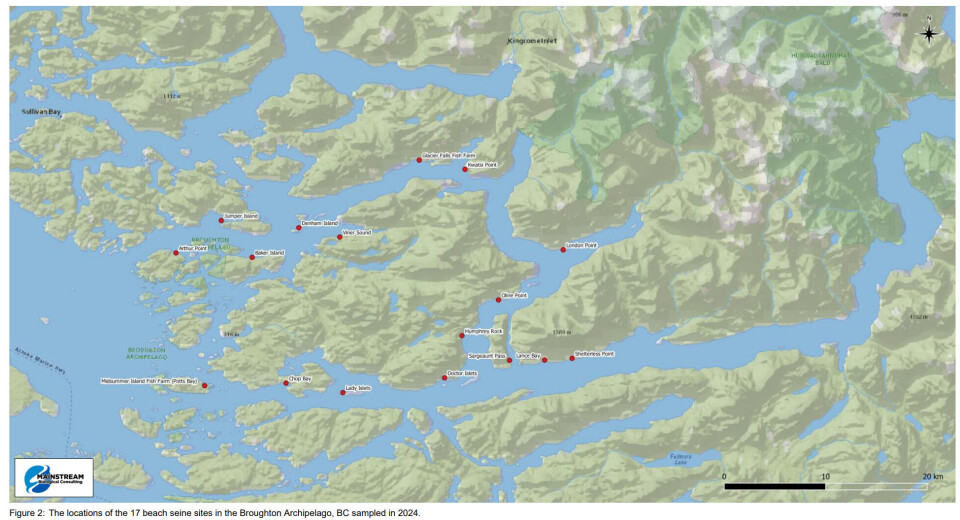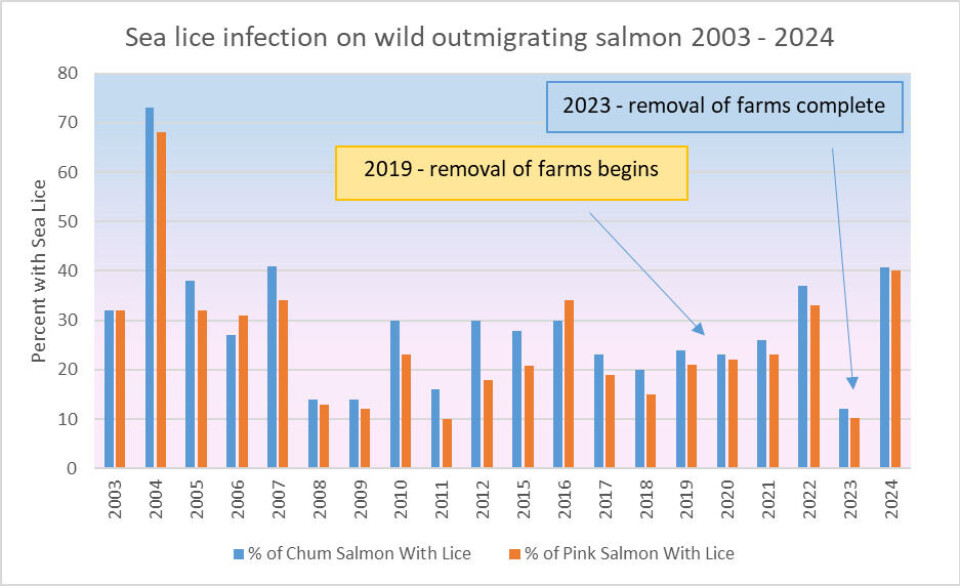
Salmon farm closures have not reduced lice infestation in British Columbia
Monitoring shows percentage of parasites on wild fish remains the same
A monitoring programme in a coastal area of Canada where salmon farms have been removed has found that the variability in the percentage of sea lice on wild Pacific salmon remains unchanged.
The average intensity (number of lice per fish) of wild Pacific salmon with sea lice in the Broughton Archipelago, British Columbia (BC), has also remained low for the last 20 years.
Salmon farms in the Broughton were removed under a phased withdrawal between 2019 and 2023 because of opposition from First Nations in the territory that blame the sector for wild salmon population declines, and in June this year the federal government said all open net pen salmon farming in BC must end by June 30, 2029.


In the latest monitoring study, beach seine sampling was conducted on behalf of BC salmon farmer Mowi Canada West in the Broughton Archipelago by a contractor, Mainstream Biological Consulting, in the spring.
Sampling was conducted at 17 sites during two separate sampling events on April 16, 2024, and May 28, 2024, selected to coincide with the peak outmigration period of juvenile salmonids. The sites were selected based on their location relative to former aquaculture sites in the area and based on historical sampling in the areas.
Fifteen individuals from each target fish species or the total number of captured individuals from each target species (if fewer than 15 were captured) were collected from each of the 17 sites during the sampling events. Total catch numbers of each species were recorded. Water quality measurements including surface and one-metre water depth temperature, salinity, and dissolved oxygen were recorded at each site during each sampling event.
The company’s 42-page report can be read here.
A 2023 Science Response from the Canadian Science Advisory Secretariat (CSAS) and long-term data collected annually in the Discovery Islands – an area in BC where salmon farms have been removed by the federal government - also concluded that sea lice on farm-raised salmon do not impact sea lice levels on wild juvenile salmon.
Continued exaggeration
Brian Kingzett, executive director of the BC Salmon Farmers’ Association, said: “The continued exaggeration of wild salmon populations declining due to sea lice from salmon farms does not help conservation efforts of wild salmon.

“Ongoing research and data support that the salmon farming sector poses minimal risk to wild Pacific salmon, yet government decisions continue to ignore the science and threaten our sector’s future.
“BC salmon farmers support wild salmon restoration, climate action and food security. It’s time for the federal government to stop using salmon farming as a scapegoat, making unrealistic and unachievable political decisions about our sector, and focus on reliable data and science to address the real issues impacting wild Pacific salmon.”
Important inaccuracies
The release of the Broughton Archipelago sampling report follows the recent publication of a literature review by three scientists from Norway, Iceland, and Canada who concluded that important inaccuracies in the current Traffic Light System (TLS) for salmon farming regulation in Norway likely result in overestimates of the effects of farm origin salmon lice on wild fish.
One of the authors, Simon Jones, emeritus scientist of Fisheries and Oceans Canada (DFO), said: “This is an important finding, as it aligns with the research and data we are seeing on sea lice in Canada.
“The highly variable relationship between lice levels on wild salmon and salmon aquaculture in BC indicates the need for a greater understanding of all factors affecting the survival of wild salmon.”
Over-prediction in Scotland
Mowi Scotland chief operating officer Ben Hadfield has also challenged modelling-based assumptions made by the Scottish Environment Protection Agency (SEPA) about the number of lice originating if fish farms and their harmful effects on migrating wild Atlantic salmon smolts.
He said calculations over-predict parasite numbers possibly by a factor of 4-5, leading to unnecessary lice treatments that impact welfare of farmed stock.























































